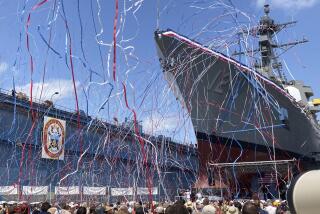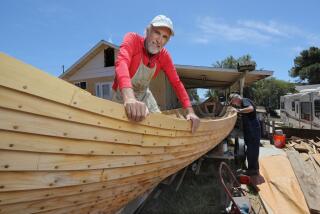Shipshape
- Share via
Gordon Hampton’s unique story begins unfortunately at the side of a Virginia road, gathers inspiration from Connecticut shores and concludes happily at an office building in Costa Mesa.
Three years ago, Hampton suffered partial memory loss and other neurological problems when two muggers assaulted him after his car broke down in Harrisonburg, Va.
Unable to immediately return to work but anxious to recuperate, the insurance executive and Army veteran embarked on an epic project: building an accurate model of the famed U.S. Coast Guard Barque Eagle, one of the most celebrated vessels in maritime history and the largest tall ship still active in the U.S. armed forces. Known for its wind-powered might, the 295-foot Eagle can reach 17 knots.
Hampton, now 53, worked in a Falmouth, Mass., shipyard as a young man and wanted to carve the scaled-down replica as a gift to his 40-year-old stepson, J. Craig Williams of Irvine, who served on the Eagle as a Coast Guard cadet in 1976. He had not built a model ship in about 20 years.
“Craig had helped me through a lot of things and I wanted to make a gift for him,” Hampton said.
*
Hampton requested the plans for the real cutter from the U.S. Coast Guard Museum in Seattle and set sail toward the arduous task of making a model of the storied Eagle, which was built by Germany in 1936 and taken by the U.S. in 1946. Berthed in New London, Conn., the vessel still is used to train cadets.
Once he had the plans, Hampton spent two years in his Virginia basement forming the deck from strips of basswood, the pilot house and radio shack from maple, the hull from lime wood, the steering station from mahogany and the keel from walnut.
He attached a gold-painted eagle to the bow, a red light beside the galley door, made deck mops from wool yarn and placed inscriptions on the signal flags. Each detail was proudly sanded, glued, steamed, bent, carved and painted with a fervent commitment to accuracy.
“I thought he was going to go blind,” said Marilyn K. Hampton, 64, Hampton’s wife and Williams’ mother. “We had to go to the doctor and get magnifying glasses.”
The project proved hard on the eyes but beneficial in other respects.
“This helped me in my rehabilitation time,” Hampton said. “Basically, for me, it was a challenge to see that I could do it.”
Satisfied with the work, the Hamptons sent the 22-by-36-inch boat, which weighs 7 pounds, from Virginia to Williams’ office in Costa Mesa. What arrived Wednesday via airfreight is hailed by some as one of the finest-known models of the Eagle.
“It’s outstanding, I’ve never seen one with such great detail,” said Dennis G. Hall, public information officer for the U.S. Coast Guard in Long Beach. “It’s extremely accurate.”
*
The two veterans, along with Marilyn Hampton, reunited for the Memorial Day weekend and gushed over the model with Hall in Williams’ skyscraper office in the South Coast Metro area.
For Williams, 40, viewing the model conjures memories of the nation’s 1976 Bicentennial celebration in New York Harbor when he was perched atop the Eagle’s main mast as a cadet during raucous celebrating.
“It was amazing,” he recalled. “There were fireworks going off, tugboats’ [water] cannons going off, just an amazing experience. The country celebrating its 200th birthday and you’re on the Coast Guard’s flagship.”
Though a treasured time, serving on the Eagle convinced Williams to leave the Coast Guard for college and then law school. He now practices environmental law.
“A lot of the summer I spent on this, I spent leaning over the lee rail,” Williams said in reference to his seasickness.
“I lost most of the food I ate on the Eagle, but I still love it and would give my right arm to sail on it again.”
So well-received were photographs of the model that an admiral is in discussion with Hampton to build another one. He is considering the project.
For now, Hampton’s only model will remain docked in Williams’ office.
More to Read
Sign up for The Wild
We’ll help you find the best places to hike, bike and run, as well as the perfect silent spots for meditation and yoga.
You may occasionally receive promotional content from the Los Angeles Times.






